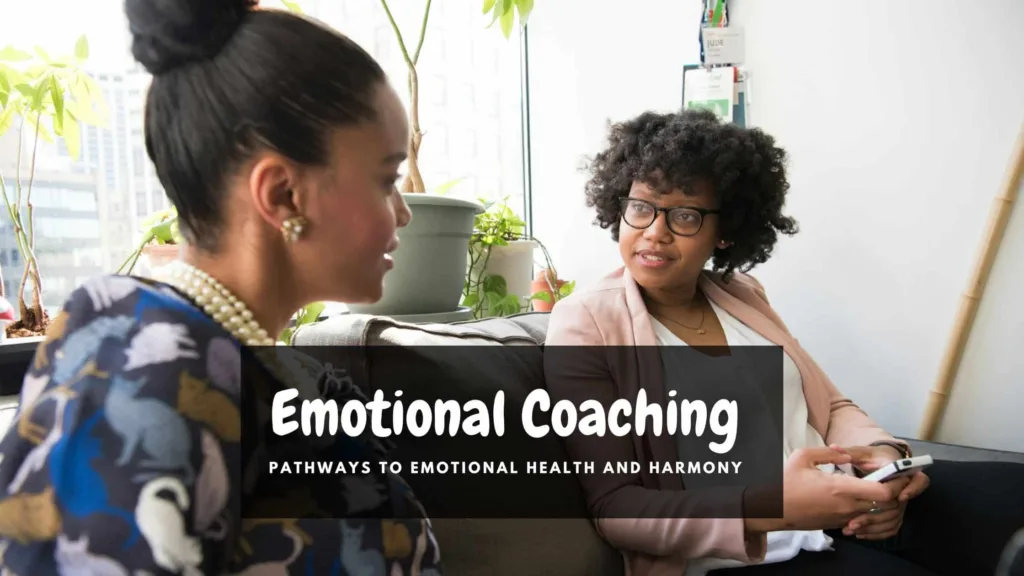Emotion coaching is a special way to help kids and grown-ups get better at handling their feelings. It was made up by a psychologist named John Gottman. Basically, it’s about paying attention to emotions, understanding them, and helping others deal with them in a nice and caring way. When people practice emotion coaching, they get better at managing their emotions. This makes their relationships stronger, helps them feel happier, and makes them stronger when dealing with tough times in life.
Understanding Emotion Coaching
Emotion Coaching is like being a helpful friend when someone is upset. Imagine a kid who’s frustrated because they can’t solve a puzzle. An emotion coach, like a parent or teacher, would first listen to the kid’s feelings without ignoring them. They might say, “I see you’re frustrated because the puzzle is hard.” Then, they’d help the kid understand it’s normal to feel frustrated sometimes. Finally, they’d suggest trying a different approach, like starting with the puzzle edges. This helps the kid learn to deal with frustration, making them stronger for next time.

Key Parts of Emotion Coaching
At its core, emotion coaching involves five key steps: awareness, connection, empathy, validation, and guidance. Let’s understand them one by one:
- Awareness: Awareness is all about recognizing and understanding emotions as they happen. It’s like noticing how you feel and understanding why you feel that way. For example, if you’re feeling sad because your friend canceled plans, awareness means recognizing, “I feel sad because I was looking forward to spending time with my friend.”
- Connection: Connection is about building strong relationships where people feel safe to share their emotions. It’s like creating a bond where you trust each other and feel comfortable talking about your feelings. For instance, if your sibling is upset because they lost their favorite toy, you might say, “I understand how you feel. It’s really hard when you lose something important.”
- Empathy: Empathy is putting yourself in someone else’s shoes and understanding how they feel. It’s like showing that you care and that their feelings matter to you. For example, if your classmate is nervous about giving a presentation, you might say, “I know presentations can be scary. You have my support, and I have faith in you.”
- Validation: Validation means accepting and acknowledging someone’s feelings, whether they’re good or bad. It’s like saying, “It’s okay to feel the way you do, and your feelings are important.” For instance, if your friend is excited about getting a good grade on a test, you might say, “That’s fantastic! You worked hard, and you deserve to feel proud of yourself.”
- Guidance: Guidance involves helping someone manage their emotions in a positive way. It’s like offering support and showing them how to deal with their feelings in a healthy manner. For example, if your little brother is angry because he lost a game, you might suggest taking deep breaths or going for a walk to calm down. This helps him learn to handle his emotions without getting overwhelmed.
Benefits
Emotion coaching offers many benefits for both children and adults, Enlisting few of them:
- Understanding Feelings Better: Emotion coaching helps us know our feelings and why we feel them, making it easier to handle them.
- Better Relationships: When we use emotion coaching, we can understand how others feel and support them. This helps us build stronger friendships and connections.
- Controlling Emotions: With emotion coaching, we learn to manage our emotions well. Instead of getting upset easily, we can stay calm and handle tough situations better.
- Dealing with Challenges: Emotionally smart people are good at dealing with problems. They know how to stay positive and find solutions, even when things are hard.
- Helping Kids Grow: Emotion coaching helps parents guide their kids through their feelings. This makes kids feel safe and loved, which is important for their growth.
- Feeling Happier: When we’re good at managing our emotions, we feel happier and less stressed. It’s like having a superpower for a happier life.
- Good Vibes at Work: In workplaces where emotion coaching is used, people feel valued and respected. This makes the environment positive and friendly.
Related Article: Psychogenic Fever: When Stress Burns
Tips to Incorporate Emotion Coaching
Here are some simple tips for bringing emotion coaching into your daily life:
- Listen and Say It’s Okay: When someone tells you how they feel, really listen and tell them it’s okay to feel that way.
- Understand How They Feel: Try to imagine how the other person is feeling and show them that you care about their feelings.
- Take Your Time: Emotions can be confusing, so give people time to talk about how they feel without rushing them.
- Teach Ways to Feel Better: Share simple tricks like taking deep breaths or talking to someone when emotions get overwhelming.
- Show Them What to Do: Be a good example by managing your own feelings calmly and positively.
- Practice Often: Make talking about feelings a regular thing with friends, family, and coworkers.
- Make Talking Easy: Create a safe space where everyone feels comfortable sharing their feelings without being judged.
- Celebrate Doing Well: When someone handles their emotions well, give them a high-five or a thumbs-up to show you’re proud of them!
Emotion Coaching helps people become better at understanding and handling their feelings. It makes them stronger and better at connecting with others. By paying attention to feelings, caring about others, understanding how they feel, and helping them cope, people can feel happier and healthier. Emotion coaching is not just good for one person—it’s good for families, communities, and groups because it creates a kind and caring environment where everyone feels understood and supported.
